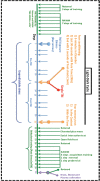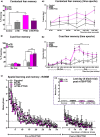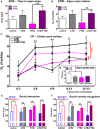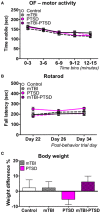Neurobehavioral, neuropathological and biochemical profiles in a novel mouse model of co-morbid post-traumatic stress disorder and mild traumatic brain injury
- PMID: 25002839
- PMCID: PMC4067099
- DOI: 10.3389/fnbeh.2014.00213
Neurobehavioral, neuropathological and biochemical profiles in a novel mouse model of co-morbid post-traumatic stress disorder and mild traumatic brain injury
Abstract
Co-morbid mild traumatic brain injury (mTBI) and post-traumatic stress disorder (PTSD) has become the signature disorder for returning combat veterans. The clinical heterogeneity and overlapping symptomatology of mTBI and PTSD underscore the need to develop a preclinical model that will enable the characterization of unique and overlapping features and allow discrimination between both disorders. This study details the development and implementation of a novel experimental paradigm for PTSD and combined PTSD-mTBI. The PTSD paradigm involved exposure to a danger-related predator odor under repeated restraint over a 21 day period and a physical trauma (inescapable footshock). We administered this paradigm alone, or in combination with a previously established mTBI model. We report outcomes of behavioral, pathological and biochemical profiles at an acute timepoint. PTSD animals demonstrated recall of traumatic memories, anxiety and an impaired social behavior. In both mTBI and combination groups there was a pattern of disinhibitory like behavior. mTBI abrogated both contextual fear and impairments in social behavior seen in PTSD animals. No major impairment in spatial memory was observed in any group. Examination of neuroendocrine and neuroimmune responses in plasma revealed a trend toward increase in corticosterone in PTSD and combination groups, and an apparent increase in Th1 and Th17 proinflammatory cytokine(s) in the PTSD only and mTBI only groups respectively. In the brain there were no gross neuropathological changes in any groups. We observed that mTBI on a background of repeated trauma exposure resulted in an augmentation of axonal injury and inflammatory markers, neurofilament L and ICAM-1 respectively. Our observations thus far suggest that this novel stress-trauma-related paradigm may be a useful model for investigating further the overlapping and distinct spatio-temporal and behavioral/biochemical relationship between mTBI and PTSD experienced by combat veterans.
Keywords: anxiety and social behavior; cognitive function; mild traumatic brain injury; mouse models; plasma and brain biomarkers; post-traumatic stress disorder.
Figures











Similar articles
-
Impact of Repetitive Mild Traumatic Brain Injury on Behavioral and Hippocampal Deficits in a Mouse Model of Chronic Stress.J Neurotrauma. 2019 Sep 1;36(17):2590-2607. doi: 10.1089/neu.2018.6314. Epub 2019 May 23. J Neurotrauma. 2019. PMID: 30963958 Free PMC article.
-
Controlled Low-Pressure Blast-Wave Exposure Causes Distinct Behavioral and Morphological Responses Modelling Mild Traumatic Brain Injury, Post-Traumatic Stress Disorder, and Comorbid Mild Traumatic Brain Injury-Post-Traumatic Stress Disorder.J Neurotrauma. 2017 Jan 1;34(1):145-164. doi: 10.1089/neu.2015.4310. Epub 2016 Mar 30. J Neurotrauma. 2017. PMID: 26885687
-
Repeated Exposure to Experimental Pain Differentiates Combat Traumatic Brain Injury with and without Post-Traumatic Stress Disorder.J Neurotrauma. 2018 Jan 15;35(2):297-307. doi: 10.1089/neu.2017.5061. Epub 2017 Nov 20. J Neurotrauma. 2018. PMID: 28931334
-
Translational relevance of fear conditioning in rodent models of mild traumatic brain injury.Neurosci Biobehav Rev. 2021 Aug;127:365-376. doi: 10.1016/j.neubiorev.2021.04.037. Epub 2021 May 4. Neurosci Biobehav Rev. 2021. PMID: 33961927 Review.
-
Complicating factors associated with mild traumatic brain injury: impact on pain and posttraumatic stress disorder treatment.J Clin Psychol Med Settings. 2011 Jun;18(2):145-54. doi: 10.1007/s10880-011-9239-2. J Clin Psychol Med Settings. 2011. PMID: 21626354 Review.
Cited by
-
Chronic Anatabine Treatment Reduces Alzheimer's Disease (AD)-Like Pathology and Improves Socio-Behavioral Deficits in a Transgenic Mouse Model of AD.PLoS One. 2015 May 26;10(5):e0128224. doi: 10.1371/journal.pone.0128224. eCollection 2015. PLoS One. 2015. PMID: 26010758 Free PMC article.
-
Repetitive Model of Mild Traumatic Brain Injury Produces Cortical Abnormalities Detectable by Magnetic Resonance Diffusion Imaging, Histopathology, and Behavior.J Neurotrauma. 2017 Apr 1;34(7):1364-1381. doi: 10.1089/neu.2016.4569. Epub 2016 Dec 20. J Neurotrauma. 2017. PMID: 27784203 Free PMC article.
-
Gait and Conditioned Fear Impairments in a Mouse Model of Comorbid TBI and PTSD.Behav Neurol. 2018 Sep 20;2018:6037015. doi: 10.1155/2018/6037015. eCollection 2018. Behav Neurol. 2018. PMID: 30327687 Free PMC article.
-
Effects of oxytocin on methamphetamine-seeking exacerbated by predator odor pre-exposure in rats.Psychopharmacology (Berl). 2016 Mar;233(6):1015-24. doi: 10.1007/s00213-015-4184-7. Epub 2015 Dec 23. Psychopharmacology (Berl). 2016. PMID: 26700240 Free PMC article.
-
Fyn kinase inhibition reduces protein aggregation, increases synapse density and improves memory in transgenic and traumatic Tauopathy.Acta Neuropathol Commun. 2020 Jul 1;8(1):96. doi: 10.1186/s40478-020-00976-9. Acta Neuropathol Commun. 2020. PMID: 32611392 Free PMC article.
References
-
- Acosta S. A., Tajiri N., Shinozuka K., Ishikawa H., Grimmig B., Diamond D., et al. (2013). Long-term upregulation of inflammation and suppression of cell proliferation in the brain of adult rats exposed to traumatic brain injury using the controlled cortical impact model. PLoS ONE 8:e53376 10.1371/journal.pone.0053376 - DOI - PMC - PubMed
-
- American Psychiatric Association. (2013). Diagnostic and Statistical Manual of Mental Disorders, 5th Edn. Arlington, VA: American Psychiatric Publishing
LinkOut - more resources
Full Text Sources
Other Literature Sources
Miscellaneous

